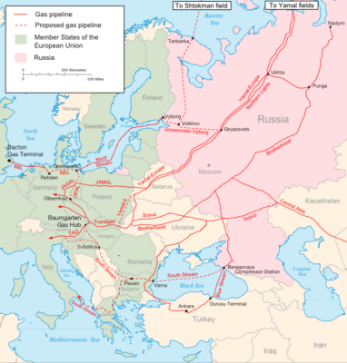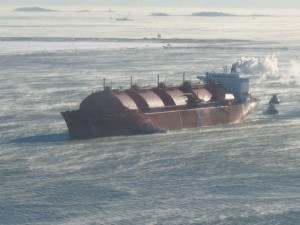
Russian and American Natural Gas in the European Market
As tensions with Russia continue to rise, officials in both Europe and the United States worry about undue Russian influence over the European gas market. They believe that if Europe relies on Russia for too much of its gas, Russia will be able to dictate any terms it wishes. If the U.S. can offer Europe an alternative source of energy, Europe will not have to rely on Russia and its influence will decline as a result. Fortunately, due to the shale gas boom, the U.S. now has an abundant supply of liquefied natural gas (LNG) readily available for export. Proponents of this argument say just send it over to Europe and the problem is solved. Unfortunately, it is not that easy.
The entire premise of the geopolitical argument over U.S. LNG exports to Europe hinges on the idea that the United States, as a unitary actor, can decide where to send its LNG. As convenient for government officials as this would be, it is simply not true. Unlike other countries, the United States does not have a state energy company. U.S. LNG is exported by privately owned companies. The President cannot simply order LNG exports to be prioritized to Europe. LNG exporters need to make a profit. If the market is not there, the gas will not flow. Markets, not government, will decide where U.S. LNG flows. Russia will continue to be Europe’s main gas supplier until at least 2020. LNG will not be the silver bullet for reducing European dependence on Russian gas.
Where is American LNG Going?

LNG tanker arrives in Boston, MA, 2005. Photo Credit Flickr user lightgraphs
Since Cheniere started exporting LNG in February, only 8% has been shipped to European markets. Instead, a majority has been sent to South America, where profits are larger due to higher prices and lower transportation costs. As demand for natural gas continues to rise in the developing world, especially in South America and East Asia, it is unlikely that American LNG forced to use Europe as a market of last resort in the near future. Asian markets in particular have the potential to be very lucrative for U.S. LNG as oil prices rebound, since Asian gas prices are commonly linked to local oil prices.
Even if the European market becomes an attractive market for U.S. LNG, there are still hurdles to overcome. Sufficient LNG terminals in the U.S. are still being built. On the European side, most regasification capacity is located in Spain and France and has limited capacity to be sent east. Many European countries are building new LNG terminals or expanding old ones, but it will take several years for all of this capacity to be realized. Importantly, while Europe is often discussed as a single market, this is not accurate. While the European Commission supports a European fully-integrated energy market it is not yet a reality. Neither the infrastructure, nor the political will is there yet. If the U.S. LNG is shipped to Europe, it would not be entering a unified market.
What Can be Done About Russian Gas?
Some have argued that U.S. LNG will lead to a price war in Europe. However, something more akin to a price preemptive strike has actually occurred. Russia and Norway have both increased pipeline gas flows to Europe. While one must be skeptical of Russian claims that they are not dumping gas on the market to price out U.S. LNG, whatever the reason, U.S. LNG is not penetrating the European market. As long as U.S. LNG is unprofitable in Europe it will be required to find markets elsewhere, exactly as Russia prefers.
However, this is not a problem. It does not matter if Europe buys a large share of its gas from Russia. As ASP has noted before, it is the United States’ ability to export LNG to Europe that makes it more secure, not the raw percentage of Europe’s gas that comes from America. The possibility of U.S. LNG being imported to Europe has caused Russia to lower its prices and therefore is able to extract fewer energy rents from Europe. Additionally, the presence of U.S. LNG on the market makes it impossible for Russia to try to exploit gas for political gain. If Russia were to cut off supplies to Europe, there would be U.S. LNG to make up the difference. While in this scenario it is unlikely that LNG could make up the difference entirely and would take some time to arrive, it would certainly mitigate the problem.
Policy makers have better things to worry about, and things they can control more easily, than Russian domination of Europe’s gas market.






